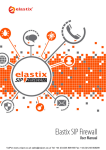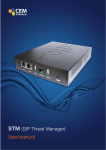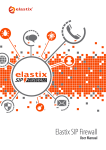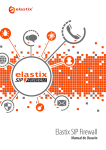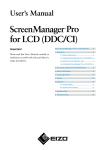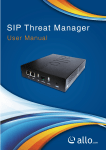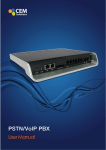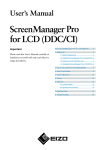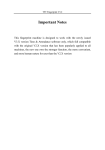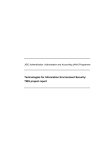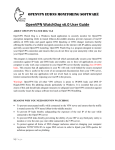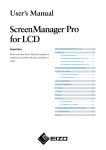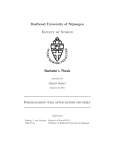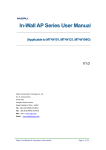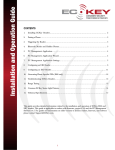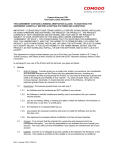Download User Manual
Transcript
User Manual ALLO STM Appliance 1.0 Version 1.0 Table of Contents 1. Introduction .......................................................................................................... 1 1.1. Overview: .................................................................................................................... 1 1.2. STM Deployment Considerations................................................................................ 3 2. Initial Setup & Configuration ............................................................................... 4 2.2. Default Configuration................................................................................................... 4 2.3. Accessing the WebUI .................................................................................................. 5 2.4 WebUI Session timeout ................................................................................................ 7 2.5 WebUI Settings ............................................................................................................ 7 2.4 Dashboard .................................................................................................................... 8 3. Configuring the Device ........................................................................................ 9 3.1. General Settings........................................................................................................ 10 3.2. Time Settings ............................................................................................................ 11 3.3. Management Access ................................................................................................. 11 3.4. Signature Update ...................................................................................................... 12 3.5. Logging...................................................................................................................... 13 4. Configuring the SIP Security Policies .............................................................. 14 4.1. SIP Security Settings................................................................................................. 14 4.2. DPI Signatures .......................................................................................................... 14 4.3. Firewall Rules ............................................................................................................ 16 4.4. White list Rules.......................................................................................................... 16 4.5. Blacklist Rules (Static)............................................................................................... 17 4.6. Dynamic Blacklist Rules ............................................................................................ 18 4.7. Geo IP Filter .............................................................................................................. 18 5. Status .................................................................................................................. 19 5.1. Security Alerts ........................................................................................................... 19 6. Device Administration ....................................................................................... 20 6.1. Administration............................................................................................................ 20 6.2. Diagnostics ................................................................................................................ 20 6.3. Ping ........................................................................................................................... 21 User Manual v1.0 www.allo.com 1 6.4. Traceroute ................................................................................................................. 22 6.5.Troubleshooting.......................................................................................................... 22 6.6. Firmware Upgrade..................................................................................................... 23 User Manual v1.0 www.allo.com 1 STM- Introduction 1. Introduction 1.1. Overview: Allo STM is an appliance based VoIP threat prevention solution dedicated to protect the SIP based PBX/Telecom Gateway/IP Phones/Mobile devices deployments. The appliance runs the Real time Deep Packet Inspection on the SIP traffic to identify the VOIP attack vectors and prevents the threats impacting the SIP based devices. The appliance has been made to seamlessly integrate with the existing network infrastructure and reduces the complexity of deployment. The appliance feature set includes, • Analyze SIP packets using the Real time Deep Packet inspection engine. • SIP Protocol Anomaly detection with configurability of detection parameters. • Detection and Prevention of the following categories of SIP based Attacks. ¾ Reconnaissance attacks ( SIP Devices Fingerprinting, User enumeration, Password Cracking Attempt ) ¾ Dos/DDos Attacks ¾ Cross Site Scripting based attacks. ¾ Buffer overflow attacks ¾ SIP Anomaly based attacks ¾ 3rd Party vendor vulnerabilities ¾ Toll Fraud detection and prevention ¾ Protection against VOIP Spam & War Dialing • Attack response includes the option for quietly dropping malicious SIP packets to help prevent continued attacks • Dynamic Blacklist Update service for VOIP, SIP PBX/Gateway Threats • Configurability of Blacklist/Whitelist/Firewall rules. • Support for Geo Location based blocking. • Provide the option to secure against PBX Application vulnerabilities • Operate at Layer 2 device thus transparent to existing IP infrastructure - no changes required to add device to your existing network 1 User Manual v1.0 www.allo.com STM- Introduction • Web/SSL based Device Management Access which will allow managing the device anywhere from the Cloud. • Ability to restrict the device management access to specific IP/Network. • Provide System Status/Security events logging option to remote syslog server. • Provides the SIP throughput up to ~10Mbps. • Support for Signature update subscription and automated signature update mechanism. • The device has been made to operate with default configuration with just powering on the device. No administrator intervention is required to operate the device with default configuration. • USB based power supply • Optional support for security events logging on the USB based storage. Technical Specifications Functional Mode Transparent Firewall with SIP Deep Packet Engine. SIP Intrusion/Prevention ~400+ SIP Attack Signatures Support Throughput ~10Mbps No of concurrent calls supports 50 concurrent calls Logging Local Security Event Console, Remote Syslog Device Management Web GUI via Https & SSH CLI Hardware MIPS based 32bit Processor Single core, 300MHz Primary Storage 16 MB Flash RAM 64MB Secondary Storage USB Storage devices support for logging ( Optional) Interfaces Two Fast Ethernet Interfaces. 2 User Manual v1.0 www.allo.com STM- Introduction 1.2. STM Deployment Considerations The STM has been made to protect the SIP based PBX/Gateway Servers against SIP based network threats and anomalies. Thus it is recommended to deploy the STM along with the PBX/Gateway deployment as given in the following scenarios based on what is applicable in the user’s setup. Deployment Scenario 1 Note: Some of the PBX/Gateway devices may have an exclusive LAN/Mgmt Interface for device management purpose other than the Data Interface (also referred as WAN/Public Interface). In such cases LAN port of the STM should be connected to the Data Interface (WAN/Public Interface). Deployment Scenario 2 In the case of PBX deployed in the LAN Setup, the following setup is recommended as it would help to protect against the threats from both Internal Network as well as the threats from the Public Cloud penetrated the Non SIP aware Corporate Firewall. 3 User Manual v1.0 www.allo.com STM – Initial Setup 2. Initial Setup & Configuration 1. 2. 3. 4. 5. 6. Unpack the items from the box Check that you have all the items listed in the package content. Connect the appliance to the power socket using the USB power cable. Connect the LAN port of the STM to the PBX/VOIP Gateway. Connect the WAN port of the STM to the untrusted/public network. The device will take about a minute to come up & will be fully functional with the default configuration. Note: Some of the PBX/Gateway devices may have an exclusive LAN/Mgmt Interface for device management purpose other than the Data Interface (also referred as WAN/Public Interface). In such cases LAN port of the STM should be connected to the Data Interface (aka WAN/Public Interface). The device operates as transparent bridging firewall with Deep Packet Inspection enabled on the SIP traffic. By default, the appliance has been made to acquire the IP Address via DHCP. The device has been made to be fully functional with the default configuration. However if the user needs to tune the device settings & the DPI policies, user can tune the configuration via the Device WebUI. Important Note: a) We strongly recommend you to change the Nano2PBX Admin Password from Factory default to Alpha numeric password to reduce the possibility of a security breach. b) Use Mozilla Firefox Only! c) Bootup process of the Nano2PBX takes about 3-4 mins 2.2. Default Configuration The device operates as transparent bridging firewall with Deep Packet Inspection enabled on the SIP traffic. By default, the appliance has been made to acquire the IP Address via DHCP. The device has been made to be fully functional with the default configuration. However if the user needs to tune the device settings & the DPI policies, He/She can tune the configuration via the Device WebUI. 4 User Manual v1.0 www.allo.com STM – Initial Setup The device all provides the command line interface accessible via SSH, which will allow to configure the basic settings and view device status. Management Access Login Credentials WebUI admin/admin SSH CLI admin/stmadmin 2.3. Accessing the WebUI To access the device WebUI, 1. Connect the serial console the serial port of STM device. 2. Use the following serial console settings to access the 'Shield' CLI i. Speed : 38400 ii. Parity : None iii. Data :8 iv. Stopbits : 1 v. Flowcontrol : No 3. From the 'Shield' command prompt, execute the following command to view the IP Address acquired by the device. shield>show ip Now you can access the device from the browser using the URL as given below https://<device-ip> Note: The WebUI has been made accessible only via HTTPS. The Device WebUI Server has been made to use Self signed PKI Certificate, Thus the browser will prompt to accept the self signed certificate generated by the device on accessing the WebUI. The recommended browser for accessing STM WebUI is Mozilla Firefox. Note: If you are not running the dhcp server in your deployment OR device fails to acquire the ip address, set the ip address from the console CLI using the command line shield>set ip <ipaddress> <mask> <gateway> 5 User Manual v1.0 www.allo.com STM – Initial Setup Verify the address using the ‘show ip’ command.Then use this IP address, to access the WebUI/SSH to configure the device configuration further. On launching the STM WebUI, the web application will prompt enter the administrator credentials to login. The WebUI login session has been made to time out and if the user does not enter the login credentials for 30 seconds and will redirect to the informational page. The user can click the hyperlink named as ‘login’ appearing on the information page, to visit the login page again. If somebody is already logged in to STM WebUI session, the subsequent attempts to login will notify the details previous login session as illustrated below and will prompt the user to override the previous session and continue OR to discard the attempt the login. 6 User Manual v1.0 www.allo.com STM – Initial Setup 2.4 WebUI Session timeout After logging into the WebUI, if there is no activity until the WebUI session timeout period ( By default, the WebUI session timeout is set to 900 seconds ), then the login session will automatically terminated and browser will be redirected to login page again. 2.5 WebUI Settings To change the WebUI settings, click the settings icon that appears top right corner (below the Apply Changes button). The WebUI settings dialog will be displayed on the browser and allow the administrator to configure WebUI session timeout & WebUI login password. To configure the WebUI login password, the user needs to enter the previously set administrator password. 7 User Manual v1.0 www.allo.com STM – Initial Setup 2.4 Dashboard On logging into the STM WebUI, the dashboard will be shown. The user can visit dashboard page from the any configuration page in the STM WebUI, by clicking the STM Product Icon that appears in the left corner of the Top panel. The status panel that appears below the top panel shows the time settings on the device and STM firmware version, Page refresh icon and Setting icon. On clicking the page refresh button, the main content area in the current page will be refreshed. On clicking settings icon, the pop menu which contains menu options logout, WebUI settings will be shown. System Status Panel shows Device up time, Memory Usage, Flash Usage & CPU Usage. Sig Update Version Panel shows STM Signature version and Release State. Network Status Panel shows IP, LAN MAC, WAN MAC and Gateway of the device. Security Alert Summary Panel shows hyperlinks for viewing of Top 10 Signatures hit, Top 10 Categories hit, Top Attacker IP Addresses & Top 10 target destinations. 8 User Manual v1.0 www.allo.com STM- Device Configuration 3. Configuring the Device Configuration pages of the STM WebUI have been made as self- intuitive and easy to configure. All the configuration pages have been made to work with the two-phase commit model. Note: The two-phase commit model is not applicable to time settings and signature update settings. In these settings, the changes will be applied directly on clicking the ‘Apply’ in the content area of the configuration editor. i.e. When the administrator changes the settings in the configuration pages and click the Save button, the settings will be saved in a temporary buffer location on the device. On saving the configuration changes, the ‘Apply Changes’ button that appears in the right top corner will be enabled & the ‘Ignore Changes’ button will appears next. The number of configuration changes will appear on the immediate left to the ‘Apply Changes’ button. To view the details of the configuration changes, the user can click the number icon, which will open the configuration changes listing. The user can apply the configuration changes to the device, by clicking ‘Apply Changes’ button. On clicking the ‘Apply Changes’ button, the configuration changes will be applied to the system and updated configuration will be persisted permanently onto the device. 9 User Manual v1.0 www.allo.com STM- Device Configuration In case if the user want abandon the configuration changes made, he can click the Ignore Changes button. On clicking the ‘Ignore Changes’ button, the configuration changes stored in the temporary buffer location will be discarded. Note: On applying the configuration changes, the ‘Ignore Changes’ button will be disabled, he/she cannot choose to ignore configuration changes. The ‘Ignore Changes’ button will be disabled, only when there are pending configuration changes that need to be applied yet to the device. Note: If the administrator tries to configure a configuration element to the inappropriate value, then the tooltip icon that appears next to each configuration element will provide the details on the error. On clicking the help icon that appears next to the configuration title, the help section corresponding the current configuration page will be launched. 3.1. General Settings The General settings page will allow configuring the host/network settings of the STM appliance. The device that has been made to work in bridging mode can either choose to work with static ip assignment or to acquire the device ip via dhcp . The page also allows to enable/disable the SSH Access to the device. The ‘Allow ICMP’ option will configure the device to respond to the ICMP ping messages sent to STM appliances or not. By the SSH Access and ICMP Ping messages are allowed to the STM appliance. 10 User Manual v1.0 www.allo.com STM- SIP Security Policy Configuration 3.2. Time Settings The administrator can choose to set the manual time settings on the device or configure the device to sync the time settings from a ntp server. Appropriate time settings/timezone should be set on the device for the correct timestamp to appear on the SIP security alerts generated by the device. 3.3. Management Access The access the STM Device management (SSH CLI / WebUI Access) can be restricted with the management access filters. By default, the access has been allowed to any global address and management vlan network configuration configure on the device. The administrator can override these settings. 11 User Manual v1.0 www.allo.com STM- SIP Security Policy Configuration The administrator needs to configure the IP Address or the IP Network or the Range of IP Addresses from with management access to the device should be allowed in the management access filter rule. The IP Type ‘ANY’ indicates global network ( Any network/ip address ). The search option in the management access filters table will help in selectively viewing the management access filter rules whose name/address values that match with the search criteria. 3.4. Signature Update To enable the automatic signature update, select the checkbox ‘enable update’ on the device and configure the signature update schedule. The valid subscription key and correct signature update url should be configured for the signature update to happen. To update the signatures on the device instantaneously, Click ‘Update Signatures now’ button. Note: When the user buys the STM appliance, the device will be shipped with the SIP signatures that will help in protecting against the SIP based attacks known as of date. However, if the user wants to ensure that his/her SIP Deployments gets the protection against the newer attack vectors, it is recommended to enable the signature update on the device. Please check with Allo Shield Sales representative on getting the details of purchasing the STM signature subscription key. 12 User Manual v1.0 www.allo.com STM- SIP Security Policy Configuration 3.5. Logging The administrator can configure the STM appliance to send the security alerts generated on detecting the SIP based attacks, to the remote syslog server. The logging page will allow enable/disable the remote logging of security alerts and to which syslog server the security alerts are to be forwarded. 13 User Manual v1.0 www.allo.com STM- SIP Security Policy Configuration 4. Configuring the SIP Security Policies 4.1. SIP Security Settings The SIP Deep packet inspection engine running the STM appliance has been made to inspect the SIP traffic with the SIP Security Compliance rules in built into the SIP DPI engine. The SIP Security Compliance parameters are configurable from the SIP Security settings page. The page also allows configuring the SIP ports on which the SIP DPI happens & RTP ports in use in the target deployment. 4.2. DPI Signatures The SIP DPI Configuration page allows toe configure the SIP Deep packet Inspection rules categories. The administrator can enable/disable the inspection against particular category of rules, action to be taken on detecting attacks matching the rules in the categories. The possible actions that the STM can execute are log the alert, block the packets containing the attack vector and blacklist the ip for the given duration. The blocking duration of how long the attacker up needs to be blocked is also configure per category level. 14 User Manual v1.0 www.allo.com STM- SIP Security Policy Configuration The table given below lists the SIP Deep packet Inspection rules categories supported in STM and configuration parameters in each category. Category Possible Actions User Configurable options SIP Reconnaissance Attacks Log the alert/Block the attack/Blacklist attacker ip - SIP Devices Scanning Log the alert/Block the attack/Blacklist attacker ip SIP Dos Attacks Log the alert/Block the attack/Blacklist attacker ip Threshold/Intervel SIP DDos Attacks Log the alert/Block the attack/Blacklist attacker ip Threshold/Intervel SIP Anomaly attacks Log the alert/Block the attack/Blacklist attacker ip - SIP Buffer overflow attacks Log the alert/Block the attack/Blacklist attacker ip - SIP Cross site scripting Log the alert/Block the attack/Blacklist attacker ip 3rd Party vendor vulnerabilities Log the alert/Block the attack/Blacklist attacker ip 15 User Manual v1.0 www.allo.com STM- SIP Security Policy Configuration 4.3. Firewall Rules The firewall rules configuration will allow the administrator in configuring what traffic should be allowed to protected SIP PBX/Gateway network from untrusted wan zone, besides DPI enabled SIP traffic and RTP traffic. The administrator needs to specify the source and destination networks and port numbers and protocol that will be used as the matching criteria in the filtering rule and action to be taken on matching the filtering rule. The possible actions are to block the traffic and allow the traffic on matching the filtering rule. The rules precedence will be in the order in which the rules configured on firewall rules table. 4.4. White list Rules This page allows to configure the white listed ip addresses in the untrusted wan zone from which the access to communicate with the protected SIP network will be allowed by the STM firewall. This page will also allows configuring whether the white rules take precedence over the blacklist rules (both static and dynamic) configured on the device at any instant. 16 User Manual v1.0 www.allo.com STM- SIP Security Policy Configuration 4.5. Blacklist Rules (Static) This page allows to configure the black listed ip addresses in the untrusted wan zone from which the access to communicate with the protected SIP network will be blocked by the STM firewall. This page will also allows configuring whether the white rules take precedence over the blacklist rules (both static and dynamic) configured on the device at any instant. 17 User Manual v1.0 www.allo.com STM- SIP Security Policy Configuration 4.6. Dynamic Blacklist Rules The dynamic blacklist rules are the blocking rules added by the STM SIP deep packet inspection engine to block the traffic from attacker ip addresses for the blocking duration configured in the rules category, on detecting the attack. The dynamic blacklist rules will allow the administrator to see the dynamic blacklist rules currently configured on the device at any instant. In case if the administrator wants to override and allow the traffic from particular blacklisted ip, he can delete the rule from the dynamic blacklist rules page. 4.7. Geo IP Filter The administrator can choose to block the traffic originating from the specific countries towards the protected SIP network, by configuring the GeoIP filter rules in STM 18 User Manual v1.0 www.allo.com STM- Status 5. Status 5.1. Security Alerts The status alerts page shows the list of alerts pertaining to the SIP attacks detected the STM SIP Deep packet inspection engine at any instant. The administrator can choose to set log viewer page refresh interval in this page. The option to download the security alerts shown in this page in CSV format is available in the page. Note: Unless the user configures to forward the security alerts to remote syslog server, the security alerts are not persisted permanently on the device. The logging buffer location will be flushed at the predefined interval (not configurable) will once the logging threshold criteria met. However if the administrator wants to persist the alerts into an usb storage, he/she can connect the usb storage to the usb data port of STM appliance. The rotated logs will be automatically archived in CSV format in to usb storage by the STM appliance. 19 User Manual v1.0 www.allo.com STM- Device Administration 6. Device Administration 6.1. Administration The Administration user interface page provides the option for running factory reset on the device, restarting the device, device reboot, device shutdown & Configuration backup/restore. Running factory-reset on the device requires reboot, thus the administrator will be redirected wait notification page on clicking the factory reset button and will be prompted login once the device comes up with the default configuration. The STM appliances support taking the configuration backup and restore the configuration later. Note: The configuration backup will contain the lastly persisted configuration. If there are any transient changes that are yet to be applied while taking the backup, those configuration changes will not be included in the configuration backup archive. 6.2. Diagnostics The diagnostics page will allow the administrator to gather the troubleshooting logs which will help Allo Support team in debugging any issues faced with STM deployment setup. 20 User Manual v1.0 www.allo.com STM- Device Administration To run the utility on the device, the administrator needs to click the ‘Run diagnostics’ button. The device will run the diagnostics task in the backend and display the results once the task is complete. The administrator can download the reports by clicking the ‘Get Report’ button and send the report to Allo Support team 6.3. Ping The administrator can troubleshoot the network connectivity issues with running ping from the STM device. The administrator needs to enter the IP address that needs to be pinged from the STM appliance/ping count and click the ‘Ping’ button to run the task.The ping results will be displayed in the text area once the ping task is complete. 21 User Manual v1.0 www.allo.com STM- Device Administration 6.4. Traceroute The administrator can troubleshoot the network connectivity issues with running traceroute from the STM device. The administrator needs to enter the IP address to which the route needs to be traced from the STM appliance/hop count and click the ‘Traceroute’ button to run the task. The traceroute results will be displayed in the text area once the traceroute task is complete. 6.5.Troubleshooting This page will allow disable/enable the DPI on the STM appliance for troubleshooting purposes. 22 User Manual v1.0 www.allo.com STM- Device Administration 6.6. Firmware Upgrade The STM appliance supports the manual upgrade on the STM firmware running on the appliance. The firmware upgrade page shows the currently running STM firmware version and allows the administrator to upload the firmware update package onto the device and install. To install the firmware, • • • • • Download the STM firmware update package from Allo website and keep it your local system. From the browser in your local system, login to STM WebUI and launch the STM firmware upgrade page. Click the ‘Browse’ in the firmware page and select the STM firmware update package file that you saved in your local system. After selecting the file, click the ‘Upgrade’ button. The device will verify the firmware uploaded and install. After install the device will reboot and administrator will be redirected the login page. Thanks for Choosing Allo STM. Any Technical assistance required, Kindly raise the support ticket at http://support.allo.com/ 23 User Manual v1.0 www.allo.com



























